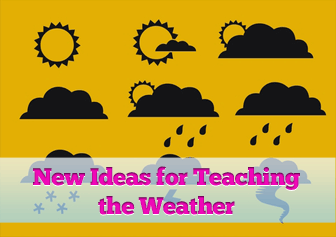☂ W: Weather Caster for a Day [Teacher Tips from A to Z]
![☂ W: Weather Caster for a Day [Teacher Tips from A to Z]](/uploads/posts/2011-08/1313561787_esl-weather.png)

In honor of the organization that provides so much essential information to the U.S. on a daily basis, take some time out of your normal ESL activities to do some new activities with the weather.
Your Weather Up Next
Studying the weather offers a unique opportunity for reading practice. By giving your students a copy of a weather map available in a national newspaper (like USA today), they can get an idea of the weather in a large area. Before they can understand the map, though, you will need to review the different symbols that are used there. Depending on the age of your students, they may or may not be familiar with the terms warm front, cold front, high-pressure area and low-pressure area and the symbols which represent them on the map. Give your students some background on the words and the symbols, and then challenge their reading skills by asking information that they can only find on the weather map. You can also find national weather maps on weather.com and other web sites. You may want to have your students compare the data presented on maps from different sources and see if the data match. If not, why do they think there are discrepancies?
Your students can get some listening practice with the local weather as well. Either during the news broadcast or later on the channel’s web site, play the weather segment for your students, and then ask some comprehension questions to see how much they understood. For lower level students you may want to keep your comprehension questions simple. What weather is expected? How should you dress for this weather? For more advanced students, ask more advanced questions. What are the expected high and low temperatures? What time is sunset? You should vary your questions based on the information that the newscaster presents.
Severe Weather
You hope that it is not too often, but there are times when severe weather threatens your location. Make sure your students understand what “severe weather” means, and then as a class brainstorm a list of the possible conditions that may be considered severe weather. Your list should include hurricanes, tropical storms, tornadoes, blizzards, hail, tsunami, freezing rain and strong winds. To go with your list of severe weather terms, have your students list what the effects of this type of weather can have on the area it hits. They should include dangers to people in the area as well as potential damages to surroundings.
Using the list of severe weather conditions you have compiled, have each student select one type of severe weather to research. She should gather information to include in a brochure on how to behave in that particular type of severe weather. Your students should write out the warning signs of their particular weather, what to do if that weather hits, how to prepare in advance for that weather, and which areas of the country are most likely to be affected and when. Then she should compile that information into a brochure. Copy each brochure and then send it home with each of your students. Encourage your students to talk with their families about severe weather conditions that they might experience and to make a family plan in case of an emergency. FEMA has a useful template available on their website that you may want to send home with each of your students to use with their families.
More than Just Local
Tracking weather does not have to be a local only activity. In today’s world, communication is easier than ever, and the globe has never seemed smaller. Have your class take a global approach to the weather by tracking the conditions in another world city. You can choose your cities in a couple of different ways. One way is to have each student select a city from his native country and then do a daily check of the weather in that location. Another way to choose cities for your students would be to compile a large list of cities that they think might have interesting weather. If you put each city on a small slip of paper, have your students draw a city from the slips of paper, and that city will be his assignment for the remainder of the month.
Every day, for one month, each student should record the weather conditions of his city. You should require measurements on temperature, rainfall, wind and sky conditions. If you like, you can challenge your students for additional information like allergen levels, dew points or wind chill. When the month is up, have your students compile their information in some type of graph. Then, give each student an opportunity to share some of his information with the class.
While each student is tracking the weather for his individual city, your class should track the weather for the city in which you live. Again, at the end of the month tabulate the data. You can then have your students compare and contrast the weather in your city with the city they tracked throughout the month. Is there a city they would prefer to their own because of the weather?
Take your weather studies to the next level this month in honor of the National Weather Service’s birthday on October 1st with these not so typical weather activities!